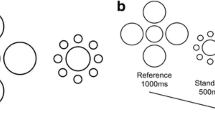Abstract
Vignettes depicting a mildly or severely self-abusive child with profound mental retardation who received either a differential reinforcement of other behavior or a contingent electric shock treatment were presented to 161 undergraduates. After subjects rated the acceptability of the given treatment on the Treatment Evaluation Inventory (TEI), they evaluated the efficacy of the given treatment based upon six AB data graphs. Visual analytic judgments were not significantly effected by type of treatment, severity of self-injurious behavior (SIB), or the treatment × SIB interaction. TEI scores differed significantly according to type of treatment. Simple and multiple correlations computed between TEI scores and graph evaluations provided evidence ofacceptability bias, such that more favorable appraisals of treatment acceptability were related to perceptions of greater treatment effectiveness.
Similar content being viewed by others
References
Cavell, T. A., Frentz, C. E., & Kelley, M. L. (1986a). Acceptability of paradoxical interventions: Some nonparadoxical findings.Professional Psychology: Research and Practice, 17, 519–523.
Cavell, T. A., Frentz, C. E., & Kelley, M. L. (1986b). Consumer acceptability of the single case withdrawal design: Penalty for early withdrawal?Behavior Therapy, 17, 82–87.
DeProspero, A., & Cohen, S. C. (1979). Inconsistent visual analysis of intrasubject data.Journal of Applied Behavior Analysis, 12, 573–579.
Frentz, C. E., & Kelley, M. L. (1986). Parents' acceptance of reductive treatment methods: The influence of problem severity and perception of child behavior.Behavior Therapy, 17, 75–81.
Gottman, J. M., & Glass, G. V. (1978). Analysis of interrupted time-series experiments. In T. R. Kratochwill (Ed.),Single-subject research: Strategies for evaluating change (pp. 197–235). New York: Academic Press.
Kazdin, A. E. (1980a). Acceptability of alternative treatments for deviant child behavior.Journal of Applied Behavior Analysis, 13, 259–273.
Kazdin, A. E. (1980b). Acceptability of time-out from reinforcement procedures for disruptive child behavior.Behavior Therapy, 11, 329–344.
Kazdin, A. E. (1981). Acceptability of child treatment techniques: The influence of treatment efficacy and adverse side effects.Behavior Therapy, 12, 493–506.
Kazdin, A. E. (1982).Single-case research design: Methods for clinical and applied settings. New York: Oxford University Press.
Kazdin, A. E. (1984). Acceptability of aversive procedures and medication as treatment alternatives for deviant child behavior.Journal of Abnormal Child Psychology, 12, 289–302.
Kazdin, A. E., French, N. H., & Sherick, R. B. (1981). Acceptability of alternative treatments for children: Evaluations for inpatient children, parents, and staff.Journal of Consulting and Clinical Psychology, 49, 900–907.
Kratochwill, T. R., & Brody, G. H. (1978). Single-subject designs: A perspective on the controversy over employing statistical inference and implications for research and training in behavior modification.Behavior Modification, 2, 291–307.
Maytas, T. A., & Greenwood, K. M. (1990). Visual analysis of single-case time series: Effects of variability, serial dependence, and magnitude of intervention effects.Journal of Applied Behavior Analysis, 23, 341–351.
Miltenberger, R. G., Lennox, D. B., & Erfanian, N. (1989). Acceptability of alternative treatments for persons with mental retardation: Ratings from institutional and community-based staff.American Journal on Mental Retardation, 93, 388–395.
Ottenbacher, K. (1986). Reliability and accuracy of visually analyzing graphed data from single-subject designs.American Journal of Occupational Therapy, 40, 464–469.
Ottenbacher, K. (1990). Visual Inspection of single-subject data: An empirical analysis.Mental Retardation, 28, 283–290.
Parsonson, B. S., & Baer, D. M. (1986). The graphic analysis of data. In A. Poling & R. W. Fuqua (Eds.),research methods in applied behavior analysis: Issues and advances (pp. 299–311). New York: Plenum Press.
Singh, N. N., Watson, J. E., & Winton, A. S. W. (1987). Parents' acceptability ratings of alternative treatments for use with mentally retarded children.Behavior Modification, 11, 17–26.
Spirrison, C. L. (1992). Measurement and meaning: The treatment acceptability construct and comments on Lundervold et al. (1991).Behavioral Residential Treatment, 7, 259–264.
Spirrison, C. L., Noland, K. A., & Savoie, L. B. (1992). Factor structure of the Treatment Evaluation Inventory: Implications for measurement of treatment acceptability.Journal of Psychopathology and Behavioral Assessment, 14, 65–79.
Tarnowski, K. J., Rasnake, L. K., Mulick, J. A., & Kelly, P. A. (1989). Acceptability of behavioral interventions for self-injurious behavior.American Journal on Mental Retardation, 93, 575–580.
Tarnowski, K. J., Mulick, J. A., & Rasnake, L. K. (1990). Acceptability of behavioral interventions for self-injurious behavior: Replication and interinstitutional comparison.American Journal on Mental Retardation, 95, 182–187.
Author information
Authors and Affiliations
Rights and permissions
About this article
Cite this article
Spirrison, C.L., Mauney, L.T. Acceptability bias: The effects of treatment acceptability on visual analysis of graphed data. J Psychopathol Behav Assess 16, 85–94 (1994). https://doi.org/10.1007/BF02229067
Accepted:
Issue Date:
DOI: https://doi.org/10.1007/BF02229067




